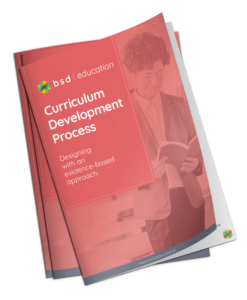
Design with an Evidence-Based Approach
Our pedagogical foundation and curriculum development process is built from studying educational research and from decades of practical experience in classrooms all over the world.
Learn more about what stands behind BSD’s 600+ hours of certified curriculum.
Meeting the Challenges of the Digital Learning Gap
In an effort to address the Digital Learning Gap, BSD Education has designed a comprehensive technology education product that can be used by teachers of any skill level or background.
Our approach to addressing the Digital Learning Gap is to provide digital skills curriculum that uses professional tools, is scaffolded for ease of learning, is rooted in personally relevant topics, allows for personalization and customization, and is supported through professional development and ongoing support.
To help us address the Digital Learning Gap, we are driven by 4 main theories of action, presented below.


1. BSD Pedagogical Foundation
At BSD Education, we design our projects, lessons, and technology solutions from a strong pedagogical foundation, believing that:
a) teachers need high quality support for digital learning,
b) learning by doing is the most practical approach in education, and
c) a mixture of scaffolded learning and open-ended projects provide students with the support they need to be successful.
“The most effective teachers have deep knowledge of the subjects they teach, and when teachers’ knowledge falls below a certain level it is a significant impediment to students’ learning.”
– “What makes great teaching?“(Coe, et al. 2014)
2. The BSD Curriculum
All of our lessons, projects and curriculum follow a learning cycle that is designed to match the pedagogical framework that we have described above, called Explore, Learn, Create.


3. Best Practices in Curriculum Design
Along with our foundational pedagogy and learning cycle, we also follow evidence-based practices for curriculum design.
Teaching through Real-World Connections
Our lessons are designed to create authentic learning experiences where students can experience connections to real world issues and problems, exposing them to key global issues and themes.
Teaching Social Emotional Learning
Our curriculum designers use a social emotional learning lens when designing lessons that connect to key issues in social justice, critical race pedagogy, and culturally relevant practices.
Best Practices in Computer Science Education
Our team consults best practices in computer science education in our approach to designing and developing coding projects that align to rigorous standards such as CSTA and ISTE.
User Experience and Interface Design
We design our platform so that students and teachers can easily operate and navigate through it in an intuitive and logical manner. Continual improvement on the design of our product relies on feedback from customers and prioritisation for new developments and features, using the RISE methodology for continuous improvement.
4. Digital Skills for the Workforce of Tomorrow
To prepare students for undefined futures where artificial intelligence, augmented reality and data privacy are all emerging topics with tremendous impacts on society, we embed 4 approaches into our curriculum that have been identified as future proof and fundamental:
a) Computational Thinking
b) Design Thinking
c) Coding/Programming
d) Digital Citizenship


Certified Exellence
BSD Education has earned the Research-Based Design Product Certification from Digital Promise. The Research-Based Design Product Certification uses a competency-based learning framework, developed in consultation with Digital Promise’s Learner Variability Project advisory board, expert researchers in the Learning Sciences field, and nearly 50 educators across the United States.
At BSD Education, we know that in order to provide high quality products to teachers and students, it must start with a strong foundation that comes from research, proven methods, and from best practices within the fields of education and the workforce.

See BSD's full curriculum process and pedagogical foundation
Want more? Download BSD’s Curriculum Development Process to learn more about research-backed critical theories of action and key approaches that drive success in the classroom and back our pedagogical foundation.
A look inside:
- Four main theories of action to address the Digital Learning Gap
- Key approaches to curriculum identified as future proof and fundamental
- A snapshot of the research supporting BSD’s logic model
Want your school to be
all set for digital skills?
Our turnkey solution provides everything you need from resources, tools and unrivaled support for you to bring digital skills learning to your classroom.
